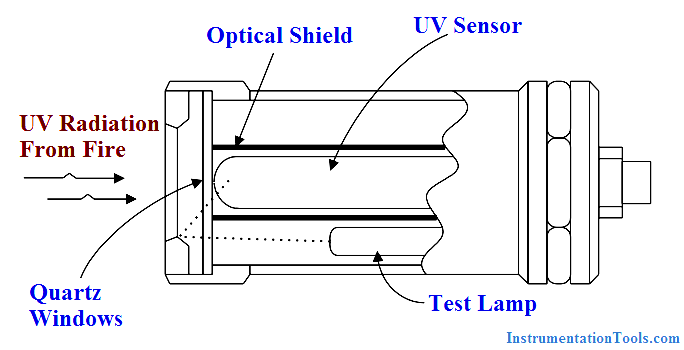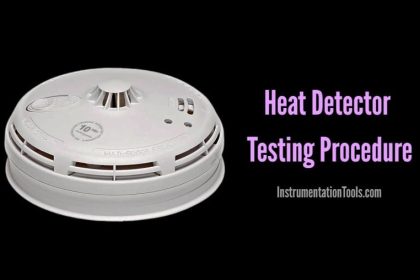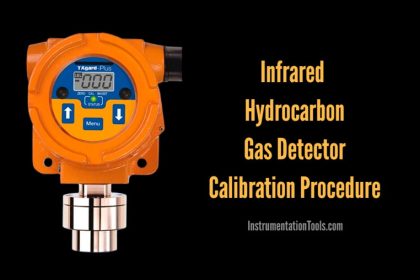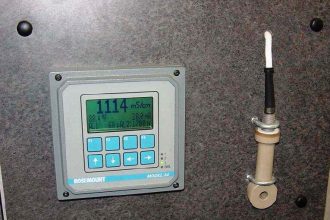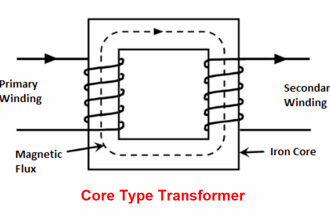Generally fires are preceded by generation of heat (rise of temperature) and generation of smoke. Hence heat, smoke and flame detection systems must be used to alert personnel, shutdown equipment and activate automatic fire extinguishing system.
In process plants, sudden release of hydrocarbon / self igniting fluids may develop rapidly into a fire. In such cases it is imperative that fire is detected right at inception. Fire detectors are the devices which effectively carry out this task.
Following are the types of fire detectors – depending on their specific properties and their specific field of application.
1. Detection by persons (with manual call points)
2. Optical fire detectors
- Infrared (IR) fire detectors
- Ultraviolet (UV) fire detector
- UV / IR fire detector
Detection by persons
Manual call points popularly known as MCP is of the break-glass, auto release type.
The complete housing of manual call points installed outdoors is constructed in accordance with requirements for the classified hazardous areas, be corrosion-resistant and fully weather-proofed. For identification, they are coloured red to DIN Standard RAL 3000 or equivalent.
To actuate the MCP, glass has to be broken when there is any emergency.
Basically, there are two types of MCPs are being used :
- Digital MCPs
- Analog MCPs
Digital MCPs :
The MCP is having microswitch of NO contact which is in normal conditions pressed by the break glass thus closing the contact. When glass is broken the microswitch gets released and changes its contact from closed position to open position and gives an Alarm condition.
Analog MCPs :
This type of MCP is having the resistors. Breaking of the glass results in the operation of micro switch which forces the contact changeover. Lower value resistance is coming in the line, which increases the current that can be used for the alarm. Analogue MCPs are used where monitoring of the input device is required for checking the availability of the functional device.
Optical type fire detectors
There are three types of Optical fire detectors :
Infrared type fire detectors
All objects with a temperature greater than absolute zero emit IR radiation. Most IR sensors are broad band detectors (i.e. they respond to wide range of wavelengths). Consequently, they require an optical filter to narrow the response to the wavelength of interest. The carbon dioxide in the earth’s atmosphere absorbs virtually all the solar radiation in 4.2 to 4.5 micron range.
Consequently a high intensity of 4.2 to 4.5 micron radiation at ground level can only be from hot body or carbonaceous fire. For this reason fire detection based upon response to this range only is solar blind. Discrimination between hot bodies and fires is achieved by monitoring the characteristic flame flicker frequency of 1–10 Hz.
These are used where fast detection of a hydrocarbon fire, or of other flammable products with a high hydrocarbon content, is of prime importance. These detectors are based on the flame-flicker principle, i.e. the detector responds to the flickering of most hydrocarbon fires. They are not suitable for the detection of smouldering fires.
IR detectors are practically not affected by smoke or oil vapors, do not respond to arc welding as ionizing radiation (e.g. non destructive testing – X-Ray) and are less affected by dirt on the lens than UV detectors. However they do not respond to non carbon flames such as hydrogen and hydrogen sulphide. The most promising type of IR detector is the single wavelength, solar blind detector, responding to radiation in the 4.3 to 4.5 micron range.
The most common wavelength of interest is 4.35 micron, the carbon dioxide emission band, because burning carbonaceous material produces large amounts of carbon dioxide.
NOTE: IR type fire detectors have an upper ambient temperature limit of 70 °C.
Area of Detection : Cone of sight
Advantages :
1. Sensitivity not impaired (as UV) by less contamination and smoke absorption of radiation.
2. Not affected by welding, X-rays.
Limitations :
1. Spurious trips due to heat shimmer, vibrating machinery, flare reflections.
UV type fire detectors
An Ultra violet (UV) radiation detector contains a sensing element (solid state or gas filled tube) which is responding to a band of radiation with a wavelength shorter than 2800 m-10 (Angstrom). The sensor consists of a multiplying detector (usually Geiger Muller type ionization tube) mounted inside a metal casing with a quartz lens.
Amplifying and monitoring circuits may be incorporated within the detector head, or located separately in a remote controller.
When ultra violet radiation falls on the lens, the tube becomes conducting thereby activating the alarm control circuits. The effect of transient signals such as lightning can be eliminated by an integrated circuit.
UV radiation is strongly absorbed by smoke and to some extent by various vapors. UV detectors are highly susceptible to optical obscuration of the lens (e.g. dirt, salt, oil mist).
They can pick up electric arc welding radiation at long distances even by reflection; they also respond to ionizing radiation (e.g. non destructive testing) and reflected radiation from open flames (e.g. reflection on the sea surface of flares).
The most commonly used UV detector is provided with lens checking device (manually or automatically activated), which produces a fault signal when a certain threshold of obscuration has been reached. The detector sensitivity at this point is, however, unacceptably reduced for many fire protection applications.
The typical UV detector is as shown is Fig.
Ultraviolet light type detectors are also extremely fast in detecting fire but they should not be applied in dusty environments or in an environment with airborne oil droplets or where fires are expected to produce heavy smoke which may foul the lens. UV detectors are normally used, for example, for fire detection under the hood of gas turbines.
NOTE:
1) UV detectors are subject to interference from welding activities, X-rays used in non-destructive testing and lightning.
2) These detectors have an upper ambient temperature limit of 150 °C.
Area of Detection : Cone of sight
Advantages :
1. Not affected by sunlight, or adverse weather
2. Detectors can be self testing
Limitations :
1. Spurious trips due to lightning, X-rays, welding and flares.
2. Dust, salt etc. on lens can hinder detection
3. Smoke absorbs UV light
UV / IR type fire detectors
These detectors are used in applications where the use of either Ultra Violet (UV) or Infra Red (IR) detectors alone can result in false alarms.
When used alone the UV detector can respond to the sources of UV radiation besides flame, such as lightning, X-ray or arc welding. Likewise and IR detector can respond to various photo objects such as flickering, or chopped radiation from electric heaters or exhaust manifolds. These detectors should have an automatic self test facility.
These detectors are used for fire detection in the following applications :
- Oil & Gas Plants
- Gasoline transport loading terminals
- Offshore drilling & production platform
- Tank farms
- Refineries
- Butane & Propane loading & storage
- Pipeline compressor stations
- Gas gathering facilities
- Turbine enclosures
- Aircraft hangers
- Paint spray booths
- Petrochemical plants
Area of Detection : Cone of sight
Advantage :
Reduced spurious alarms.
Disadvantage :
Not detecting some fires.
